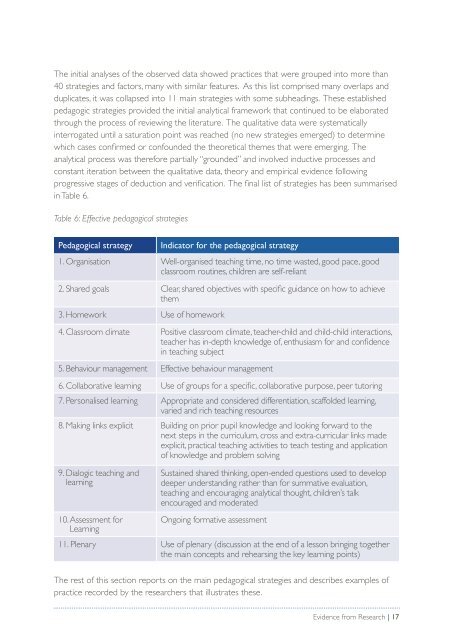Pearson-Exploring-Effective-Pedagogy-in-Primary-Schools
Pearson-Exploring-Effective-Pedagogy-in-Primary-Schools
Pearson-Exploring-Effective-Pedagogy-in-Primary-Schools
You also want an ePaper? Increase the reach of your titles
YUMPU automatically turns print PDFs into web optimized ePapers that Google loves.
The <strong>in</strong>itial analyses of the observed data showed practices that were grouped <strong>in</strong>to more than40 strategies and factors, many with similar features. As this list comprised many overlaps andduplicates, it was collapsed <strong>in</strong>to 11 ma<strong>in</strong> strategies with some subhead<strong>in</strong>gs. These establishedpedagogic strategies provided the <strong>in</strong>itial analytical framework that cont<strong>in</strong>ued to be elaboratedthrough the process of review<strong>in</strong>g the literature. The qualitative data were systematically<strong>in</strong>terrogated until a saturation po<strong>in</strong>t was reached (no new strategies emerged) to determ<strong>in</strong>ewhich cases confirmed or confounded the theoretical themes that were emerg<strong>in</strong>g. Theanalytical process was therefore partially “grounded” and <strong>in</strong>volved <strong>in</strong>ductive processes andconstant iteration between the qualitative data, theory and empirical evidence follow<strong>in</strong>gprogressive stages of deduction and verification. The f<strong>in</strong>al list of strategies has been summarised<strong>in</strong> Table 6.Table 6: <strong>Effective</strong> pedagogical strategiesPedagogical strategy Indicator for the pedagogical strategy1. Organisation Well-organised teach<strong>in</strong>g time, no time wasted, good pace, goodclassroom rout<strong>in</strong>es, children are self-reliant2. Shared goals Clear, shared objectives with specific guidance on how to achievethem3. Homework Use of homework4. Classroom climate Positive classroom climate, teacher-child and child-child <strong>in</strong>teractions,teacher has <strong>in</strong>-depth knowledge of, enthusiasm for and confidence<strong>in</strong> teach<strong>in</strong>g subject5. Behaviour management <strong>Effective</strong> behaviour management6. Collaborative learn<strong>in</strong>g Use of groups for a specific, collaborative purpose, peer tutor<strong>in</strong>g7. Personalised learn<strong>in</strong>g Appropriate and considered differentiation, scaffolded learn<strong>in</strong>g,varied and rich teach<strong>in</strong>g resources8. Mak<strong>in</strong>g l<strong>in</strong>ks explicit Build<strong>in</strong>g on prior pupil knowledge and look<strong>in</strong>g forward to thenext steps <strong>in</strong> the curriculum, cross and extra-curricular l<strong>in</strong>ks madeexplicit, practical teach<strong>in</strong>g activities to teach test<strong>in</strong>g and applicationof knowledge and problem solv<strong>in</strong>g9. Dialogic teach<strong>in</strong>g andlearn<strong>in</strong>g10. Assessment forLearn<strong>in</strong>gSusta<strong>in</strong>ed shared th<strong>in</strong>k<strong>in</strong>g, open-ended questions used to developdeeper understand<strong>in</strong>g rather than for summative evaluation,teach<strong>in</strong>g and encourag<strong>in</strong>g analytical thought, children’s talkencouraged and moderatedOngo<strong>in</strong>g formative assessment11. Plenary Use of plenary (discussion at the end of a lesson br<strong>in</strong>g<strong>in</strong>g togetherthe ma<strong>in</strong> concepts and rehears<strong>in</strong>g the key learn<strong>in</strong>g po<strong>in</strong>ts)The rest of this section reports on the ma<strong>in</strong> pedagogical strategies and describes examples ofpractice recorded by the researchers that illustrates these.Evidence from Research | 17


